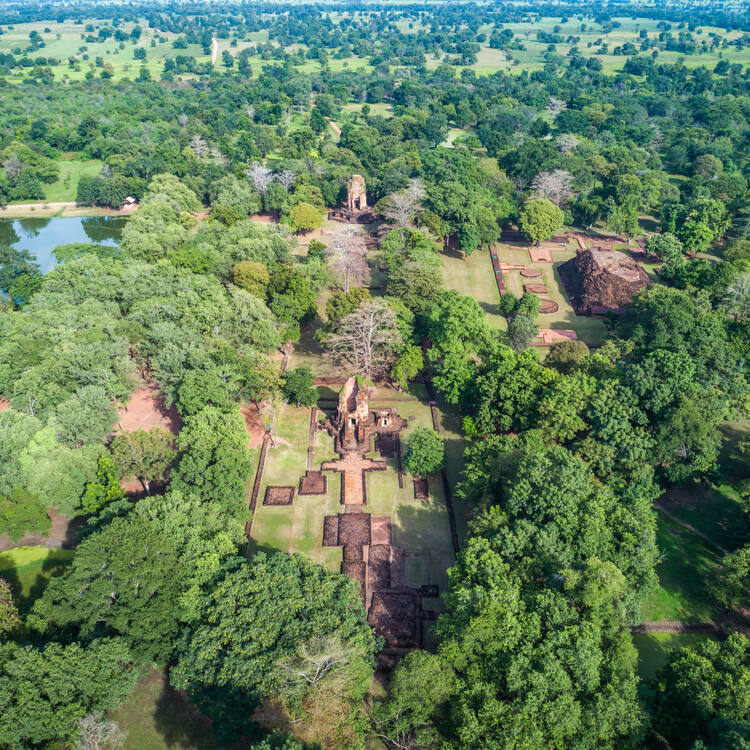The Ancient Town of Si Thep and its Associated Dvaravati Monuments
The Ancient Town of Si Thep and its Associated Dvaravati Monuments
Description is available under license CC-BY-SA IGO 3.0
La ville ancienne de Si Thep et ses monuments de Dvaravati associés
Description is available under license CC-BY-SA IGO 3.0
المدينة القديمة في سي ثيب والمعالم الأثرية المرتبطة بها من إمبراطورية دفارافاتي
source: UNESCO/CPE
Description is available under license CC-BY-SA IGO 3.0
西贴古镇及相关陀罗钵地古迹
source: UNESCO/CPE
Description is available under license CC-BY-SA IGO 3.0
Древний город Си Тхеп и связанные с ним памятники Дваравати
source: UNESCO/CPE
Description is available under license CC-BY-SA IGO 3.0
Ciudad Vieja de Si Thep y sus monumentos asociados de Dvaravati
source: UNESCO/CPE
Description is available under license CC-BY-SA IGO 3.0
Outstanding Universal Value
Brief synthesis
The Ancient Town of Si Thep is a serial property of three component parts that represent Dvaravati culture from the 6th to the 10th centuries, an important phase in the history of Southeast Asia. The component parts are the unique twin-town lay-out of the Ancient Town of Si Thep (component part 001), featuring Muang Nai (Inner Town) and Muang Nok (Outer Town) surrounded by moats; Khao Klang Nok ancient monument (component part 002), the largest surviving Dvaravati monument; and, the Khao Thamorrat Cave ancient monument (component part 003), a unique Mahayana Buddhist cave monastery that contains important examples of Dvaravati art and sculpture.
More than 112 significant monastery sites have been identified at Si Thep, and the local adaptation of Hindu artistic traditions resulted in a distinctive artistic tradition known as the Si Thep School of Art which later influenced other civilisations in Southeast Asia. The round-relief sculpture without a back-support arch in the standing Tribhanga posture, depicting body movement, is especially distinctive.
Together these sites represent the architecture, artistic traditions and religious diversity of the Dvaravati Empire that thrived in Central Thailand from the 6th to the 10th centuries, demonstrating the influences from India including Hinduism, and Theravada and Mahayana Buddhism.
Criterion (ii): The Ancient Town of Si Thep demonstrates important interchanges of cultural and religious traditions that originated in India and were adapted by the Dvaravati Empire between the 6th and 10th centuries. Through these interactions, the town developed a distinctive identity expressed in its artistic and architectural traditions. The Si Thep School of Art subsequently influenced the art and architecture of other areas in Thailand. The cohabitation of Theravada and Mahayana Buddhism and Hinduism is a distinctive characteristic of Dvaravati architecture, town planning and art, and these are demonstrated by the three component parts.
Criterion (iii): The Ancient Town of Si Thep, the Khao Klang Nok ancient monument and the Khao Thamorrat Cave ancient monument bear an exceptional testimony to the Dvaravati culture and civilisation. Together, these sites demonstrate the complexity and the specific artistic and cultural characteristics of the Dvaravati period in terms of urban planning, religious architecture, and monasticism. The architectural and artistic forms of Si Thep are not found elsewhere, particularly the unique twin-town lay-out, and distinctive Dvaravati forms of sculpture such as the standing Tribhanga posture depicting body movement. The Khao Klang Nok ancient monument is the largest monument of Dvaravati art, influenced by South Indian and Indonesian artistic traditions; and the Khao Thamorrat Cave ancient monument is located in a sacred mountain and the only known cave monastery in Mahayana Buddhism in Southeast Asia.
Integrity
The three component parts contain all the attributes necessary to convey the Outstanding Universal Value of the property. The serial approach is justified, and the property presents a comprehensive understanding of the layout, planning, water infrastructure, various layers of inhabitation and evidence of the Dvaravati city and associated monuments. The attributes of the serial property have a good state of conservation and there are few pressures impacting on the sites and their wider setting.
Authenticity
The authenticity of The Ancient Town of Si Thep is demonstrated by the richness of its archaeological structures and materials including rare and distinctive Dvaravati artistic elements. Khao Klang Nok ancient monument conveys Dvaravati cosmological beliefs, and features Dvaravati architectural forms of the indented corners system, the Bua Valai base and replica Prasats for the building base decoration. Archaeological recording and continuing research are important contributors to the authenticity of the property. Repairs and other conservation interventions have been sensitively completed, and any new materials are clearly indicated as such. The sites are relatively free from development pressures.
Protection and management requirements
Legal protection for the three component parts is provided by the Act on Ancient Monuments, Antiques, Objects of Art and National Museums, B.E.2504 (1961) and its Amended Act (No.2), B.E.2535 (1992). The buffer zones are protected under the National Reserved Forest Act, B.E.2507 (1964), the Agricultural Land Reform Act, B.E.2518 (1975), and the Ministerial Regulation regarding the Enforcement of Unitary Town Plan of Phetchabun Province, B.E.2560 (2017).
A management plan is being finalised. It includes a community engagement plan, a sustainable tourism plan, and risk management. The long-term engagement and support of local communities is a key element of the protection and management of the serial property. The Memorandum of Understanding agreed by government agencies will ensure the implementation of conservation measures and ongoing community engagement.
There are few factors affecting the property at present, although it is vulnerable to climate impacts, extreme weather events and the potential loss of community support. Unlawful excavations and development pressures posed threats to the property in the past, but these are no longer current. The monitoring system should be enhanced in relation to changes in ground water, and to development of indicators which more directly measure the state of conservation of the attributes.
